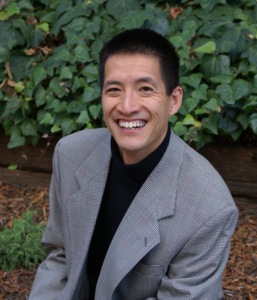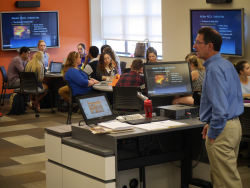
Safe Space for Free Speech
The University of Chicago made news recently because of a letter sent by its Dean of Students to inform its incoming class of freshmen that the University, given its commitment to “freedom of inquiry and expression,” does not support “trigger warnings,” cancel controversial speakers, or condone creation of “safe spaces.” Responses to this letter run the whole gamut from celebratory cheers to condemnatory curses. Some see this as the University’s honorable refusal to shut down difficult discussions of sensitive subjects; others see it as the University’s hypocritical and covert attempt to forestall student activism on campus to challenge conservative speakers or oppressive rhetoric.
I have no way of knowing the “real” motivations or intentions of this letter. I do notice, however, that subsequent conversations, whether in support or in protest of the University of Chicago’s letter, tend to assume that “free speech” will necessarily trump or preclude “safe space” or “trigger warnings” without clarifying what those terms may mean or how they may be put into practice.
As an educator who likes to encourage and enable students as well as myself to think again and think differently, I am all for free speech; free speech is, in fact, indispensable to classroom discussion and learning. We do not learn well if we feel like our thoughts and ideas are being suppressed; we also cannot learn if we are not allowed to make mistakes. Nobody’s commitment to Black Lives Matter, neither mine or any of my student’s, should keep white students in my class from articulating their disagreements with or dislike of James Cone’s Black Theology and Black Power. Similarly, advocates for LGBTQ rights, including myself, cannot silence students who want to push back against Marcella Althaus-Reid’s Indecent Theology. Every student in my classroom should have the space and time to express their thoughts and views, even if I think they are dead wrong; to deprive students of such is to take away from them an opportunity to hear and learn through feedbacks and responses. We must also not forget that persons from traditionally marginalized groups do make mistakes and can also be misguided in their thinking.
Whether this commitment to free speech and the idea of the classroom being a safe space can coexist depends on what one means by the latter. I cannot guarantee that no one will feel uncomfortable, unsafe, or threatened in my classroom since I cannot control how one feels or deny what someone is feeling. Hearing new ideas that you have not considered before, especially if it contradicts or challenges what you have held dear deep down and for very long, can indeed be very alarming. I have also heard faculty of color and female professors saying that they themselves did not feel safe at times with their students. When students are even allowed to carry guns legally on some campuses, how can I feign the power or ability to keep everybody safe in my class?
I can, however, promise that students in my courses will have a safe space to speak freely, meaning only that they will be able to say what is on their mind and in their heart, including saying, “I am feeling rather threatened!” or “I feel under attack and unsafe right now.” This kind of safe space is not one that shields students from being challenged, feeling offended, or experiencing wound or harm; it is, however, one that does not frame “free speech” and “safe space” as mutually exclusive by definition.
 Having a safe space to speak freely also does not, in my view and practice, necessarily cancel out the desire or the need for trigger warnings. A person does not have to run over other people verbally just because she or he has something important to say that others may find difficult to hear. I am not able to verify if it is true that persons of color, because of all the discrimination and marginalization, have developed thicker skins than average Whites, I will only say that some experiences, including oppressive and unjust ones, may also make someone more sensitive to other people’s feelings and she may hence become more thoughtful and more gracious about giving trigger warnings. Trigger warnings, when given clearly and concisely by a teacher on her own initiative in the classroom, do not function to shield students from but prepare students for difficult topics or challenging ideas. After giving a trigger warning, I have never once asked my students, “Is it okay to talk about this now?” or said to them, “You may leave the class if you do not want to hear or think any more about this.” More importantly, those of us who are teachers should remember that we have the responsibility to guide and guard the tone and the emotion of a classroom even or especially when we push for honest and genuine exchange of views and opinions. Let’s remember also that what we do may become models for our students to emulate. They, like us, need to learn how to disagree, debate, and argue passionately, thoughtfully, and respectfully.
Having a safe space to speak freely also does not, in my view and practice, necessarily cancel out the desire or the need for trigger warnings. A person does not have to run over other people verbally just because she or he has something important to say that others may find difficult to hear. I am not able to verify if it is true that persons of color, because of all the discrimination and marginalization, have developed thicker skins than average Whites, I will only say that some experiences, including oppressive and unjust ones, may also make someone more sensitive to other people’s feelings and she may hence become more thoughtful and more gracious about giving trigger warnings. Trigger warnings, when given clearly and concisely by a teacher on her own initiative in the classroom, do not function to shield students from but prepare students for difficult topics or challenging ideas. After giving a trigger warning, I have never once asked my students, “Is it okay to talk about this now?” or said to them, “You may leave the class if you do not want to hear or think any more about this.” More importantly, those of us who are teachers should remember that we have the responsibility to guide and guard the tone and the emotion of a classroom even or especially when we push for honest and genuine exchange of views and opinions. Let’s remember also that what we do may become models for our students to emulate. They, like us, need to learn how to disagree, debate, and argue passionately, thoughtfully, and respectfully.
Instead of following or (even in dispute) allowing the University of Chicago’s letter to set the terms of the conversation, I see the possibility for “free speech,” “safe space,” and “trigger warnings” to exist alongside each other in my classroom and in my universe.
Oh, one more thing: While a school can—and should—refuse to cancel an invited speaker with controversial viewpoints (whether the speaker is Ann Coulter or Jeremiah Wright), students and teachers can also continue their activism to speak freely against what they understand to be unjust or unacceptable. The point of activism is not to shut people up or shut people down, but to push for rethinking, reexamination, and further conversation. After all, is this not what teaching and learning is about?
Leave a Reply